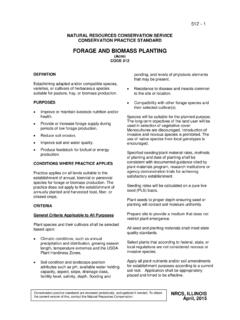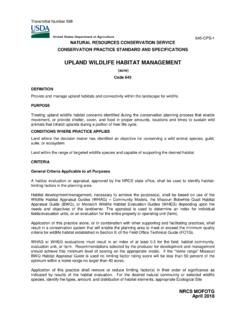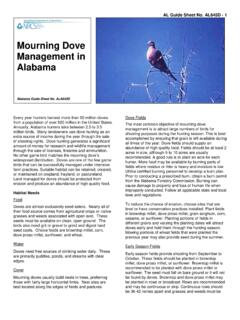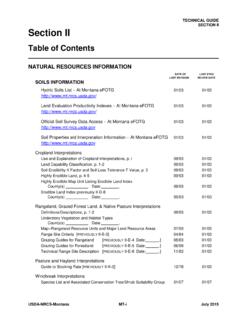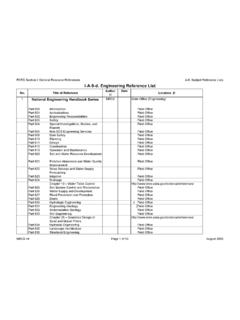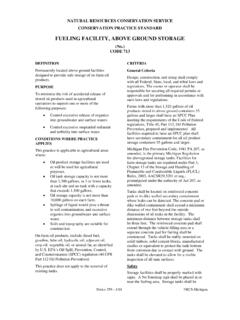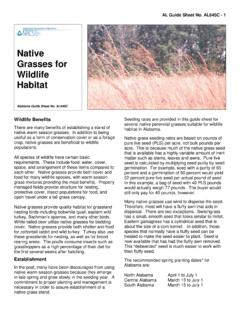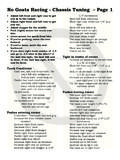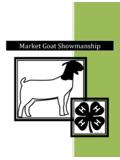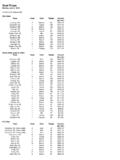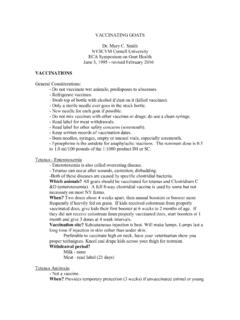Transcription of Prescribed Grazing with Goats - USDA
1 Prescribed Grazing with Goats Conservation Practice Information Sheet (IS-MO528gg) Planning Prescribed Grazing with Goats blackberry, multiflora rose, locust, sumac, winged elm, cedar and forbs such as greenbrier, NT Grazing a reduce weed and brush abundance. Goats are the spes, abandoned farmland and rangeland. Managd in substantial increases in vegetative cover of desirabl eliminating undesirable shrub species. Goats may be usek, sassafras, persimmon, buckbrush, oneysuckle, sericea lespedeza, chicory, ironweed, ox eye daisy, curly dock, pigweed, queen nne s lace, yarrow, thistle, kudzu, and other species. rush cover from 45% to 15% in one year hile sheep took three years to achieve the same results. After 5 years of Grazing Goats had ltiflora he of itical Grazing times. Grazing of multiflora se after the first of August for the first time had negligible effects.
2 Local experience in Missouri it to a ed rly xotic weeds to invade. There also the possibility of spreading weed seed from one site to another. USE OF Goats IN VEGETATION MANAGEME nimals can be used to either promote orcies of choice for controlling brush in pastureed defoliation of brush by Goats has resultee grasses and legumes while reducing ord to reduce woody species such as oahA In one Grazing study in West Virginia, Goats reduced bwreduced brush cover to 2%. Grazing management for this type of control involved brush defoliation early in the spring and repeated defoliation during the growing season. Complete defoliation starting in late summer/early fall had no impact on the woody vegetation and re-growth was 100% the following spring. In a study in North Carolina, multiflora rose bushes were practically eliminated after four Grazing seasons (97 98% dead canes).
3 Defoliating murose bushes at four to eight week intervals starting in May resulted in a 21% plant death by tbeginning of the second year, 78% by the beginning of the third year and 94% by the beginningthe fourth year. Spring and summer proved to be the crrohas shown similar results with blackberry and dewberry brambles. By itself, Grazing may not give complete eradication of a particular species but can reducemanageable or economic level. However, when a biological control such as Grazing is combinwith other control methods such as herbicides, mowing or burning, elimination may be possible and less expensive than by one of these methods alone. Use of Grazing animals, particulagoats, may be increasingly important in areas where herbicides can not be used, where other means of control are too expensive or where landowners desire biological control methods.
4 When Grazing management is not provided, these Grazing animals can cause significant damage to the environment. Overgrazing can reduce desirable plant cover, disturb soils, increase runoff and erosion potential, weaken native plant communities and allow eis STOCKING RATES NRCS Missouri 1 December 2005 The following table should be used as a guide for stocking rates when Goats for weed and brush ontrol. he sto given for excellent pasture and brushy pare not o basis but compattle. Wellent pasture you could s 8 Goats amount f land irun 1 cow. On brushy pasture you could run 9 11 Goats on the same amount f land ro run 1 olumn with Cows + Gocombineate of ows anIt is generally thought that on good to excellent pasture you can add 1 to 2 oats peithout chthe cattle stocking rate due to differences ies and razing brushy pasture the number of Goats added to an existing cattle stocking rate ould bisthe stoncation are the numbers needed on a per acre basis to radicate brush and convert to pasture in a short (2 3 year) timeframe.
5 When using Goats alone le species. uration of razing. Record the objectives, which will be for plant reduction or sustainability. The resource e o adjust becomes limited. This would include provisions for e Goats during the "off season" when forage and/or browse are not available. ONITORING nd c Pasture Type % Brush Canopy Cows Goats Cows + Goats Excellent Pasture <10% 1 6 to 8 1 +(1 to 2) Brushy Pasture 10 40% 1 9 to 11 1 +(2 to 4) Brush Eradication >40% 8 to 12 .5 +(6 to 8/ac) Sustainable BrowsMaintaining 1 to 3/ac .25 + (1 to e Management 10 < 40 % brush canopy 2)/acre Tcking ratesrison to casture atock 6 n a per acreon the sameaith excot takes to oequired td Goats . cow. The cats is a d stocking rcgr cow wanging n diet preferencghabits. with we 2 to 4 per exing cow.
6 Tcking rates give for brush eradiethe stocking rate would be 8 12 Goats per acre depending on brush density and how quick the producer wanted to eliminate the brush. The stocking rate for Goats could be reduced to 6 to 8 Goats per acre and add cow units per acre to achieve the same results and diversify income sources, assuming there is still a grass component available under the brush canopy. The stocking rate given for sustainable browse management is on a per acre basis and is the number that could be stocked to utilize and manage woody species without completely eliminating it or degrading desirab PLANNING In general the specific weed or brush species of concern and the desirable plant community will determine the number and species of Grazing animals as well as the duration and frequency of Grazing . A site specific Grazing plan should be developed that lists target species for control, owner s objectives, number and type of Grazing animal to be used and frequency and dginventory shall record the canopy of the targeted species.
7 The forage inventory should reflect thinitial forage-animal balance. The Grazing plans should also contain a contingency plan tthe stocking rates as browse/forage availabilityth M Develop a monitoring plan that includes appropriate records to measure progress toward goals. This could consist of canopy counts, Grazing records, JS-Agron-24, Pasture Condition and TreWorksheet or other measures that will provide a trend analysis. CONSIDERATIONS NRCS Missouri 2 December 2005 The client may not want to eliminate the targeted plant from the pasture, particularly if Goats are n economically beneficial enterprise. If the objectives of the Prescribed Grazing are to browse at will maintain the species for Goats , then plan accordingly.
8 Removal of some oody species may adversely impact wildlife species. If wildlife is a consideration, the objective of ages and browse. If the targeted pecies is a novel forage, there may be a conditioning period before the Goats will consume the esired forage. Goats that have prior experience will more readily begin browsing the targeted azing prescriptions are available to be used with Goats to manage problem lants: f e e on until the priority pasture plants have re-grown to about half to two-irds full size. This should take about 25-35 days. Pull the Goats out of the rotation and put them t pasture, again achieving 80 percent defoliation. Repeat this process until the esired level of reduction has been achieved. Depending upon brush species and density, it may vorable change. Once the reduction has been achieved in the d for sustained be s in the early spring.
9 Defoliate the key species of plants to about 25% of current rowth, and then rotate to the next pasture. Set the rest period so that the woody plants are not ore than twice per growing season. Select a suggested starting stocking rate of .25 Goats for each one percent of woody cover unless a forage inventory - animal balance e aan intensity thatwprescribed Grazing should be to maintain the needed amount of brush for wildlife. If the brush is too tall for the Goats , they will eat out the understory, leaving no forage for Grazing . The past browsing experience of the Goats will influence their choice of forsdplant. The following grp Plant Reduction 1. Priority Pasture Method Knock the target plants down to the Goats browsing level using mechanical, fire or other means ineeded. Use two or more pastures (five preferred), designating one as the priority pasture.
10 Ushigh density Grazing that will begin when the leaf of the target brush species is one half to two thirds full size in the spring. Use enough Goats to achieve 80% defoliation within 7 to 14 days in the priority pasture. A suggested starting stocking rate would be to stock at 1 goat per acre in thpriority pasture for each 1-3 percent of canopy cover. Rotate the Goats through the remaining pastures to maintain nutritithback into the targedtake three years to effect a fapriority pasture, then another pasture can be designated as a priority pasture and the process applied accordingly. 2. Thirty (30) Days In and 30 Days Out or Two-Pasture Switchback Method The most effective control occurs when new leaves and twigs are browsed in the initial stage of growth. Stock with enough Goats to obtain at least 65 percent defoliation in approximately 30 days.

